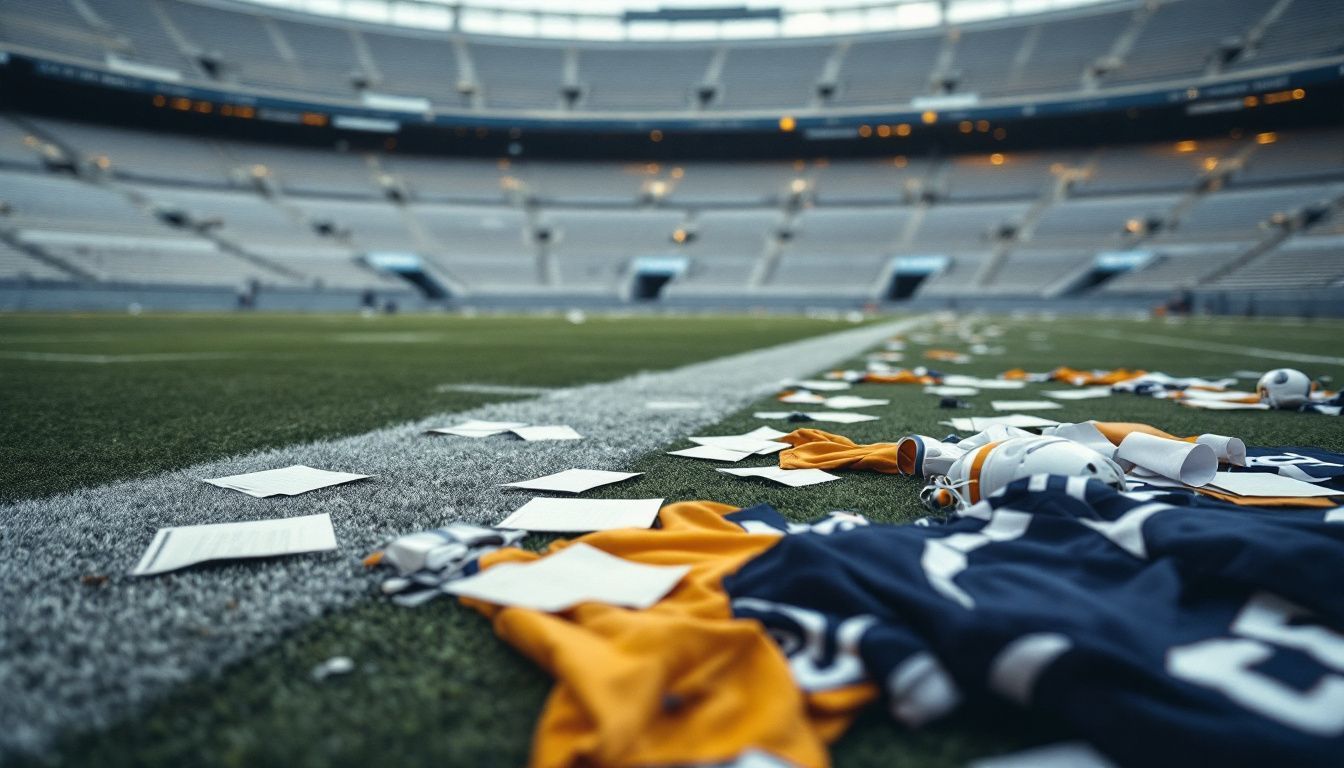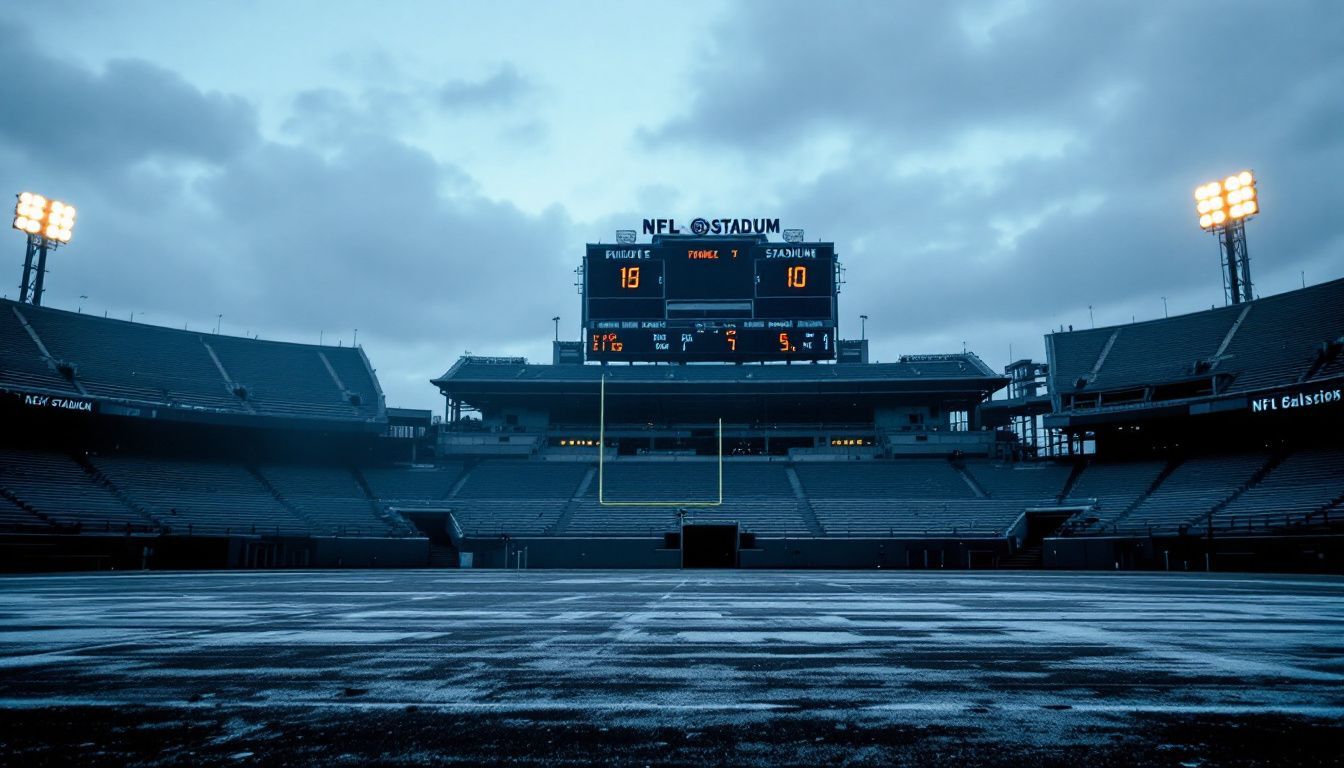Owning and franchise management of an NFL team is not just about big games and Super Bowls. It’s also about making the right decisions off the field. Many fans wonder why some teams do well while others don’t, and a significant aspect of this is effective franchise management in the NFL.
One big reason? The people in charge of the teams make a difference.
The NFL made over $20 billion last year. That shows how huge it is! Our blog will tell you what owners and franchise managers do to help their teams win, including their approach to franchise management. We talk about money, picking players, and building good places for games.
If you love football or want to know more about how it works, this is for you.
Read on to find out interesting stuff!
Key Takeaways
- NFL owners and managers make big decisions that affect their teams’ success. They collectively are the franchise management who choose players and coaches, manage money, and work on team goals.
- New rules let private equity and funds buy parts of NFL teams. This brings in more money but also raises questions about team loyalty.
- Owners balance making money with winning games. They face challenges like paying for new stadiums without public funds.
- Smart choices in player picks can lead to wins on the field and better finances. Teams have a salary cap they must follow when buying players.
- The NFL made $20.5 billion last year, showing it’s a huge business with lots at stake for owners. Thus the franchise management of their teams is critical.
NFL Team Ownership: Structure & Influence
Each of the 32 NFL teams is an independently owned franchise operating under the broader league structure. Most franchises are owned by individuals or small ownership groups. A key requirement is that one individual must own at least 30% of the franchise, except in the unique case of the Green Bay Packers, who operate as a publicly owned, nonprofit corporation with over half a million stakeholders and are led by a president and board of directors.
Main Responsibilities of Owners in Franchise Management
-
Strategic Direction: Owners are ultimately responsible for the team’s direction, big-picture business decisions, and performance outcomes, including hiring/firing general managers (GMs), head coaches, and key executives.
-
Operational Oversight: While some owners take an active, hands-on role in daily team and football operations (like Jerry Jones with the Cowboys), others delegate extensively to management and focus on broader business objectives, such as ticket prices, marketing, and team branding.
-
Financial Management: Owners control major financial decisions—setting budgets, approving major player contracts, overseeing sponsorship deals, and managing revenue streams such as ticket sales and merchandise.
-
League Collaboration: Owners participate in league-wide meetings, vote on policy changes, and serve on committees that shape NFL-wide regulations and initiatives. Any major league changes (e.g., rule updates or new business models) usually require a three-fourths majority vote among owners.
-
Community Engagement: Owners also represent their teams in the community, fostering relationships with fans, local governments, and business partners to enhance the franchise’s reputation and support local causes.
NFL Ownership Rules
-
Ownership Limits: Most teams favor a single controlling owner but allow for additional limited partners. A team may have no more than 25 co-owners (with current rules starting to allow limited private equity investment in minority shares).
-
Approval Process: New ownership candidates must apply, undergo extensive vetting, and secure approval from a supermajority of current NFL owners before a sale is completed.
-
Removal: Owners may be forced out by league action, though this is rare and usually related to significant breaches of conduct or financial rules.
Franchise Management: The Front Office
General Manager (GM) and Executive Team
-
Role of GM: The GM is responsible for football operations—assembling the roster, hiring coaching staff, negotiating player contracts, and navigating the NFL draft and trades.
-
Reporting Structure: The GM typically answers directly to the owner but can have varying degrees of autonomy, depending on the owner’s preferred involvement level.
-
Front Office Teams: Beyond the GM, most franchises employ a CEO, directors of player personnel, football operations staff, and legal, compliance, and marketing teams, ensuring all facets of team performance and organizational integrity are managed.
Franchise Tag: A Management Tool
-
Franchise Tag Purpose: The franchise tag is a mechanism that allows teams to retain a key player who is set to become a free agent for one more year at a salary determined by the average of the top five players at the position or 120% of the player’s previous year salary, depending on the tag type.
-
Tag Types: There are “exclusive” and “non-exclusive” franchise tags, with varying rules on negotiations and compensation if another team pursues the tagged player.
-
Strategic Use: This tool allows team management to control roster composition and salary cap exposure while negotiating longer-term agreements or managing talent turnover
SHOP NOW ZAZZLE - CLICK BELOW
Organizational Overview
| Role | Key Functions | Main Decision Makers |
|---|---|---|
| Owner/Principal Owner | Strategic vision, business/financial oversight, hires/fires top execs | Owner, sometimes a small ownership group |
| General Manager (GM) | Player personnel, football operations, contracts, roster assembly | GM, under owner’s authority |
| CEO/President | Daily operations, business management, marketing, and non-football departments | CEO/President, reporting to owner |
| Head Coach | Team’s football strategy, training, and game management | Head Coach, hired by owner/GM |
| League Committees | Policy, rule changes, business initiatives | Owners/representatives from each franchise |
Summary
NFL owners are the ultimate decision-makers, setting the direction and tone for their franchises both on and off the field. Their roles span strategic planning, operational oversight, and collaboration with league leadership and the community.
Franchise management, led by the GM and supported by a comprehensive front office, implements day-to-day operations and manages the team’s playing personnel, utilizing tools like the franchise tag for roster and fiscal control. While ownership style varies, all teams operate within a tightly structured league framework to ensure competitive balance, integrity, and financial stability
Defining the Role of NFL Owners

Effective franchise management is crucial for the long-term success of teams, as it encompasses strategic planning, player development, and financial oversight.
NFL owners do more than just pay the bills. They set the goals and character of their football teams, steering them with careful money choices.
How NFL Owners Influence Team Decisions and League Policies
Franchise Management in Team Football Decisions
NFL owners are the ultimate authority within their franchises, and their influence over team football decisions is felt in several key areas:
-
Hiring and Firing Key Personnel: Owners appoint the general manager (GM), head coach, and other top executives. They set expectations and have the power to dismiss or retain personnel based on performance.
-
Strategic Direction: Owners set the team’s long-term vision, including overall football philosophy, level of investment in players, and risk tolerance for bold moves like trades or free-agent signings.
-
Financial Oversight: Major contracts, such as marquee player acquisitions or coaching hires, require owner approval. Owners decide on team budget and salary cap strategy, influencing roster decisions and free agency behavior.
-
Level of Involvement: Some owners are highly involved in football operations (e.g., reviewing draft boards or participating in game strategy discussions), while others delegate nearly all football decisions to their appointed executives.
-
Approval of Major Moves: While day-to-day football operations fall to the GM and coaching staff, significant moves—like relocating the franchise or massive trades—generally require direct owner approval.
Influence on League Policies
NFL owners collectively form the league’s most powerful governing group as they are key in franchise management. Thus they regularly shape policies and the direction of the NFL as a whole:
-
Voting Power: Owners meet regularly and vote on major policy changes, from rule adjustments (like instant replay or extra point changes) to business policies (e.g., revenue sharing, television deals). Most major decisions require agreement or a supermajority (75% or more) among owners.
-
Committees and Task Forces: Many owners serve on influential league committees that focus on finance, competition, labor relations, and social responsibility. These groups develop recommendations that are often adopted league-wide.
-
CBA Negotiations: Owners are central to negotiating the Collective Bargaining Agreement (CBA) with the NFL Players Association, determining salary caps, player benefits, and league structure.
-
Approval of New Owners and Franchise Moves: The group of owners must vet and approve candidates for new franchise ownership, as well as approve requests for franchise relocation.
-
Long-Term Vision and Initiatives: Owners drive league-wide strategies, such as international expansion, player safety initiatives, and marketing campaigns.
Owner’s Influence and Franchise Management
| Area | Examples of Owner Influence | Decision Level |
|---|---|---|
| Team Football Operations | Hiring/firing GMs/coaches, approving major trades/contracts | Individual Franchise |
| Financial Direction | Setting budgets, approving high-cost moves | Individual Franchise |
| NFL Policy and Rule Changes | Voting on rules, TV deals, CBA, franchise relocations | Collective League Level |
| League Committees | Serving on committees that recommend/shape policy | Collective League Level |
NFL owners shape not just their own teams but the entire direction of the league through both direct decision-making within their franchises and collective action on league-wide policies.
Owners Impact NFL Team Success and Operations
Overview
NFL owners play a pivotal role in shaping the franchise management. This involves their teams’ culture, strategic direction, and operational outcomes. Their level of involvement, leadership style, and business acumen can drive teams toward sustained success or, alternatively, perpetuate issues that impede performance both on and off the field.
Key Impacts of Ownership Involvement in Franchise Management
1. Setting Team Culture and Vision
-
Owners establish the organizational culture and set long-term goals.
-
Active, knowledgeable owners often foster cultures of ambition, accountability, and innovation.
-
Poorly involved or misaligned owners may create atmospheres of complacency or dysfunction, which can lead to ongoing underperformance.
2. Decision-Making and Personnel Choices
-
Owners are ultimately responsible for hiring/firing top-level staff such as general managers and head coaches.
-
Strategic hires (or mistakes) have direct consequences on roster construction, coaching quality, and game performance.
-
Micromanagement can undermine executive staff and create instability, while absentee or hands-off owners risk letting mediocrity persist.
3. Financial Investment and Infrastructure
-
Owners control major capital allocations, including stadium improvements, training facilities, and high-profile player contracts.
-
Substantial investment in team amenities, technology, and player experience can attract top talent and boost fan engagement.
-
Underinvestment or reluctance to spend can leave teams languishing in outdated facilities or at a competitive disadvantage.
4. Influence on Operations and Workplace Standards
-
Owners decide the resources allocated to support staff, player welfare, and workplace culture.
-
Small improvements, such as upgraded locker rooms or family support amenities, can meaningfully impact player satisfaction, recruitment, and retention.
-
Transparent, present, and supportive owners help maintain discipline and morale throughout the organization.
5. Reputation and Brand Strength
-
Owners make the large-scale business and PR decisions in franchise management, that shape how teams are perceived.
-
Positive community engagement, philanthropy, and responsible leadership contribute to team reputation and long-term brand value.
-
Dysfunctional or controversial owners can damage brand equity, fan loyalty, and ultimately, team market value
Examples
| Owner/Team | Style/Actions | Impact on Success |
|---|---|---|
| Jerry Jones (Cowboys) | Highly involved, dual owner-GM, hands-on | Early success, later mixed results due to overreach |
| Stan Kroenke (Rams) | Strategic relocation, major facility investment | Super Bowl victory, brand revitalization |
| Glazer Family (Buccaneers) | High investment, key hires (Brady, Arians) | Multiple Super Bowls, surge in franchise value |
| McCaskey Family (Bears) | Family tradition, less aggressive change | Struggles with consistent competitiveness |
Risks of Dysfunctional Ownership
-
Teams with disengaged or erratic owners often suffer from poor culture, weak accountability, and missed opportunities.
-
Dysfunctional ownership leads to frequent turnover in leadership, erodes player trust, and can alienate fans.
-
League-wide calls for increased owner accountability and transparency reflect the crucial link between ownership quality and organizational health.
Conclusion
NFL owners’ are key in franchise management and their involvement profoundly shapes both team operations and the likelihood of achieving sustained on-field success. Owners who blend strategic investment, decisive but respectful management, and positive cultural leadership give their teams the best chance to excel. In contrast, mismanagement or overreach at the ownership level can create lasting setbacks that even the most talented players and coaches struggle to overcome
Franchise Management in Establishing Mission and Identity
Creating a strong mission and identity is key for franchise management of an NFL teams. This step tells fans who they are. Teams like the Kansas City Chiefs or Dallas Cowboys stand out because of it. They build their image by winning games, community work, and how they act in public.
Owners play a big role here. People like Jerry Jones of the Dallas Cowboys make sure their team has a clear mission. They decide on goals, like winning championships or helping in their city.
This makes fans feel close to the team.
Having an identity also helps with business. It attracts sponsors and sells tickets. A team that knows what it stands for finds more success on and off the field.
Strategic Financial and Franchise Management
Moving from setting a team’s mission and identity to managing its finances is a big step. NFL owners play a crucial role here, as they must make smart money choices to keep the team profitable and competitive.
With the NFL’s 32 teams bringing in an estimated $20.5 billion last year, there’s a lot at stake.
Owners decide on spending for player salaries, training facilities, and stadiums—all of which can impact how well the team does. They look at ways to grow their income from ticket sales, merchandise, and broadcast deals.
For example, upgrading stadiums with luxury suites can attract more fans willing to pay for high-end experiences during games.
Smart financial management keeps teams winning both on the field and in the market.
This approach includes making deals that change ownership stakes or bring in new investors like private equity firms. Such moves require deep understanding of both sports and business worlds.
In franchise management the owners must balance immediate costs against future gains—whether it’s signing top players or investing in state-of-the-art playing venues.
Impact of Franchise Management on Team Success

Good franchise management makes teams win. It decides who plays and leads, shaping victory paths.
Essential Decision-Making in Player Acquisitions
Key in franchise management is picking the right players is key for a team’s success. NFL owners must decide who to bring on board. This choice affects the team’s performance and its money status. Teams look at many things before choosing a player, like skill, health, and how they fit with the team’s style.
The NFL has rules on how much money teams can spend on players. This is called a salary cap. Owners work with managers to make sure they pick good players without spending too much money.
For example, some owners might choose young talent that costs less but could be very successful in the future. Others might spend more on famous players to win now. Each decision can lead to wins or losses both on the field and in finances.
Influence on Coaching and Management Hires
NFL owners play a big role in hiring coaches and managers which is a really critical part of franchise management. They look for people who can turn their vision into wins on the field. Greg Penner, owner of the Denver Broncos, made headlines by hiring a new coach to shake things up.
Like him, other owners know that these decisions can make or break a team.
Team success often hinges on having the right leaders. Shahid Khan, who owns the Jacksonville Jaguars, once said:.
Finding the right head coach is much like finding the right quarterback.
He knows that his choices affect every part of the team from strategy to player morale.
Owners consider many things before making these hires. They want someone who fits with the team’s identity and can handle pressure well. This process shows how NFL franchises really work behind scenes – it’s not just about money but finding people who can lead teams to victory.
How to Find the Right Head Coach in the NFL
Selecting a successful NFL head coach is a high-stakes challenge that shapes the entire process of franchise management and the franchise’s future. There’s no perfect formula, but leading experts, executives, and historical trends highlight key principles for making the right hire:
Key Qualities to Seek
-
Leadership and Communication: Prioritize candidates with strong leadership skills who can inspire, motivate, and manage diverse personalities.
-
Flexibility and Adaptability: Great coaches adjust their strategies to players’ strengths and stay open to innovation.
-
Ability to Build and Trust a Staff: The best head coaches recruit top coordinators, delegate responsibilities, and foster collaborative environments.
-
Proven Track Record or Unmistakable Potential: While past success as a coordinator can help, look for those who go “beyond X’s and O’s”—demonstrating attention to detail, vision, and intent.
-
Cultural Fit: Successful hires fit their organization’s culture and have buy-in from players, ownership, and front office.
Common Hiring Guidelines
Prioritize leadership and management over technical prowess.
Seek candidates with evidence of learning and improvement.
Don’t overvalue recent team success; look at their individual contributions and context.
Identify those who do “more with less”—coaches who maximized weaker rosters.
Evaluate their plan and readiness through rigorous interviews and scenario questions
5 Examples: Good and Bad Head Coach Hires
Coach Team(s) Good/Bad Summary
Bill Belichick
Patriots/Browns Good 6 Super Bowl wins, perennial contender in modern era
Andy Reid
Eagles/Chiefs Good Transformed 2 franchises, known for innovation
Mike Tomlin
Steelers Good No losing seasons in 18 years, respected leader
Urban Meyer
Jaguars Bad Dysfunction, scandals, fired in 1st year
Matt Patricia
Lions Bad Locker room issues, poor record, quick decline
Brief Explanations
Bill Belichick (Good)
The quintessential example. His leadership, ability to build a stellar staff, and long-term vision made the Patriots a dynasty, thanks to both strategy and culture.
Andy Reid (Good)
Lauded for adapting his offense and developing quarterbacks, Reid has elevated both the Eagles and Chiefs with consistent, innovative winning.
Mike Tomlin (Good)
Hired young with limited coordinator experience, Tomlin has maintained Steelers’ stability, demonstrating consistent excellence and team management.
Urban Meyer (Bad)
Despite collegiate success, his NFL stint was marred by controversy and dysfunction, revealing the dangers of ignoring fit and professional background.
Matt Patricia (Bad)
Struggled to transition from coordinator to leader, and his confrontational style created internal strife and on-field regression.
Conclusion
The right NFL head coach must combine vision, adaptability, and strong people skills. Evaluate candidates beyond surface-level success, focusing on their leadership philosophy, ability to build relationships, and fit with the organization’s culture. Learning from the best and worst recent hires can help franchises avoid costly mistakes and secure lasting success.
What Is a Franchise Quarterback?
A franchise quarterback is a player considered the foundational leader of an NFL team, often signed to long-term contracts due to their high skill, leadership qualities, and the belief that they have the talent to win a Super Bowl. These are quarterbacks a team is committed to “building around” for the foreseeable future, usually spanning several seasons or even a decade. Criteria often include:
-
Consistent, high-level performance
-
Leadership on and off the field
-
Durability and availability
-
Ability to elevate team play, especially in big moments
-
Recognition as one of the top players in the league at their position
Top Franchise Quarterbacks Going Into the 2025 NFL Season
Here is a list of quarterbacks widely regarded as current franchise QBs, based on league rankings, executive surveys, and recent performances:
| Rank | Quarterback | Team | Notable Achievements |
|---|---|---|---|
| 1 | Patrick Mahomes | Kansas City Chiefs | 3x Super Bowl winner, 2x MVP |
| 2 | Josh Allen | Buffalo Bills | 2024 MVP, perennial contender |
| 3 | Joe Burrow | Cincinnati Bengals | 2024 passing leader |
| 4 | Lamar Jackson | Baltimore Ravens | 2x NFL MVP |
| 5 | Jalen Hurts | Philadelphia Eagles | Super Bowl appearance, 2024 SB MVP |
| 6 | Justin Herbert | Los Angeles Chargers | Multiple 4,000+ yard seasons |
| 7 | Jayden Daniels | Washington Commanders | 2024 Offensive Rookie of Year |
| 8 | C.J. Stroud | Houston Texans | 2023 Offensive Rookie of Year |
| 9 | Jared Goff | Detroit Lions | Led Lions to playoff resurgence |
| 10 | Brock Purdy | San Francisco 49ers | Super Bowl appearance as starter |
Other notable names with franchise status or strong argument:
-
Tua Tagovailoa (Dolphins)
-
Dak Prescott (Cowboys)
-
Trevor Lawrence (Jaguars)
-
Jordan Love (Packers)
-
Baker Mayfield (Buccaneers)
-
Kyler Murray (Cardinals)
Characteristics and Impact of a Franchise QB
-
Long-Term Stability: Teams with a franchise QB have organizational stability, plan their roster/budget around them, and attract top free agents.
-
Competitive Edge: They provide a winning edge, making playoff appearances and title runs more attainable, even with roster holes elsewhere.
-
Coaching & System Fit: Often, head coaches/schemes are tailored to maximize their skillsets.
-
Marketing and Fan Base: Franchise QBs drive jersey sales, team branding, and local/national fan engagement.
Recent Examples of Franchise Quarterbacks
Cornerstones of Success
-
Patrick Mahomes (Chiefs): Has led Kansas City to multiple Super Bowls, widely acknowledged as the game’s best.
-
Joe Burrow (Bengals): Transformed the Bengals from perennial underachievers into regular contenders.
-
Lamar Jackson (Ravens): His unique dual-threat ability has been pivotal to Baltimore’s modern offense.
Emerging or Recent Franchise QBs
-
Jayden Daniels (Commanders): Took Washington to the playoffs and won Offensive Rookie of the Year.
-
C.J. Stroud (Texans): Immediate impact as a rookie, giving Houston long-term hope at the position.
-
Brock Purdy (49ers): Became the full-time starter and led his team to a Super Bowl.
Recent Trends in NFL Ownership

NFL teams are now catching the eye of private money groups. Rules for who can own a team are changing, too.
Entry of Private Equity and Institutional Funds
The NFL changed its rules. Now, private equity investors and institutional funds can own pieces of teams. Before, only a few rich people could be owners. This change means big money groups like investment funds can buy into the NFL.
This brings more cash to the league and teams.
This cash helps pay for things like new stadiums and better facilities. Teams like the Carolina Panthers and the Las Vegas Raiders have seen new investors come in. These changes make owning an NFL team different than before.
Next up, let’s talk about how changing ownership rules affect everyone involved.
Changes in Ownership Rules and Their Implications
NFL has opened doors for private equity and institutional funds to step in. This move shifts how teams operate. Before, owners often came from rich backgrounds, using their wealth to buy teams.
Now, groups can own parts of a team. This change means more money might flow into the league.
This new rule also brings up questions about team stability and owner loyalty. Fans wonder if these investors will care as much about winning or the team’s roots in its city as traditional owners do.
With big money players entering the scene, the dynamics within the NFL are set for a big shift.
Challenges Facing NFL Owners and Managers

NFL owners and managers face hard choices between making money and winning games. They also have to deal with how to pay for new stadiums with tax dollars and loans.
Balancing Business Interests with Team Performance
Owners face a tough job. They must keep the business side strong while also making sure their teams do well. For example, they need to decide on money for new players and coaches. This is hard because spending more does not always mean winning more games.
The NFL made $20.5 billion last year, showing how big these choices are. Owners like Kim Pegula and Mark Davis think a lot about this balance. They look at things like franchise value and strategic initiatives to make their decisions.
Teams like the Chicago Bears and Houston Texans show us different ways to manage this balance. Some spend a lot on top players hoping it leads to wins and fans coming to games. Others focus on slowly building a good team over time, which can also draw fans but might take longer to see success on the field.
Navigating Public Funding and Stadium Financing
Getting money for a new stadium is a big deal for NFL team owners. They have to talk with cities and states about getting public funds. This means asking taxpayers to help pay for the building.
Owners say these stadiums will make the area better, bringing in more money and jobs.
But it’s not easy. Some people don’t want their tax money going to these projects. They think owners should use their own cash instead. The NFL has seen this debate many times, like with Allegiant Stadium and others across the country.
In these talks, both sides try to find a middle ground that works for everyone involved.
Conclusion

NFL owners play a big part even a key role in their teams franchise management. They set goals and manage money well. Managing a team right can make it win more. Owners decide on which players to get and who should lead the team.
Lately, more money groups buy into NFL teams, changing the game’s business side. Owners face tough choices, like improving stadiums without public funds.
Team leaders must keep both fans happy and make good deals to stay ahead. The NFL sees many family-owned teams making huge money last year. Yet, they face new rules about selling parts of their teams to others.
Owning an NFL team is not just about sports; it’s smart business too. These owners come from different backgrounds but all aim to win titles and grow their wealth.
FAQs
1. What is the role of owners in NFL franchise management in teams like the Cincinnati Bengals or San Francisco 49ers?
Owners such as Mike Brown and Michael Bidwill play a critical role in NFL franchises. They make key decisions, oversee business ventures, manage equity investments, and are involved in ownership transactions.
2. How does franchise management work in major U.S. sports leagues like the National Football League (NFL)?
Franchise management involves running all aspects of an NFL team – from hiring staff to managing private equity investments and other financial matters. Notable figures include Al Davis, Jimmy Haslam, Jerry Richardson, and David Tepper.
3. Who are some notable limited partners in major professional sports leagues in the United States?
Limited partners can be anyone from fund managers to business tycoons who’ve made illiquid asset investments into teams such as Green Bay Packers or New York Giants. Examples include Rob Walton and Carrie Walton-Penner.
4. Are there any rules that guide ownership transactions within the National Football Conference or other parts of the NFL?
Yes! The Rooney Rule is one example; it mandates that minority candidates must be interviewed for head coach positions within teams like Pittsburgh Steelers or Washington Commanders – previously known as Washington Redskins.
5.What happens when a team owner wants to sell their stake?
An auction process usually takes place where potential buyers bid on available stock options for teams like Atlanta United (MLS) or Rochester Americans (four major sports). Paul Allen’s sale of his share was one notable transaction.
6.How do owners contribute towards research related to football?
Owners often fund research initiatives aimed at improving player safety and performance — this includes everything from equipment design to game strategies.


 Cart is empty
Cart is empty 







